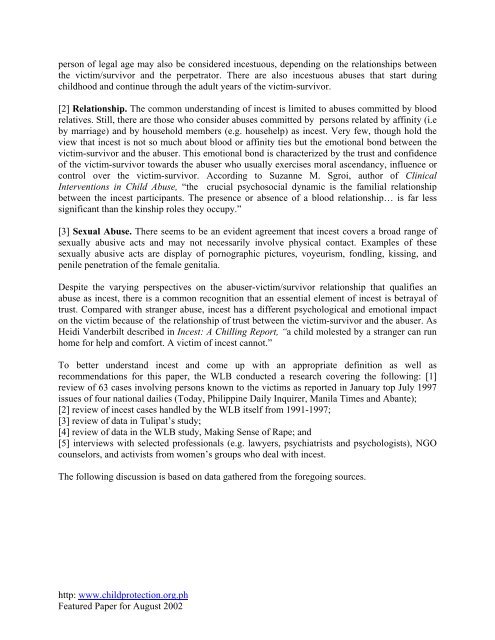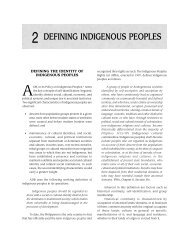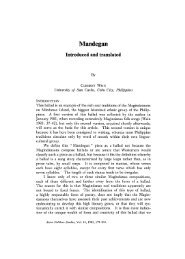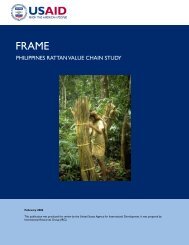were “<strong>in</strong>cest” cases. The DSWD statistical data also fails to clarify its def<strong>in</strong>ition of <strong>in</strong>cest.However, a DSWD social worker from <strong>the</strong> Bureau of Child and Youth Welfare (BCYW)clarified that until 1995, <strong>the</strong>y def<strong>in</strong>ed <strong>in</strong>cest as sexual abuse committed aga<strong>in</strong>st children andadults by persons related to <strong>the</strong> victims by blood. Accord<strong>in</strong>g to her, <strong>the</strong> BCYW expanded itsdef<strong>in</strong>ition <strong>in</strong> 1996 by <strong>in</strong>clud<strong>in</strong>g sexual abuse committed aga<strong>in</strong>st a person by any member of <strong>the</strong>household. This may also <strong>in</strong>clude househelpers. This expanded def<strong>in</strong>ition, however, is notreflected <strong>in</strong> any DSWD document.There is also no legal def<strong>in</strong>ition of <strong>in</strong>cest <strong>in</strong> <strong>the</strong> Philipp<strong>in</strong>es. The 1998 Family Code is so far <strong>the</strong>only exist<strong>in</strong>g legislation that has no reference to <strong>in</strong>cest. But its pert<strong>in</strong>ent provision (Article 37)perta<strong>in</strong>s to <strong>in</strong>cestuous marriages, not to <strong>in</strong>cest itself:“Marriages between <strong>the</strong> follow<strong>in</strong>g are <strong>in</strong>cestuous and void from <strong>the</strong> beg<strong>in</strong>n<strong>in</strong>g, whe<strong>the</strong>r <strong>the</strong> relationship between<strong>the</strong> parties be legitimate or illegitimate: (1) Between ascendants and descendants of any degree; and (2)Between bro<strong>the</strong>rs and sisters, whe<strong>the</strong>r of full or half blood.”The only official document <strong>in</strong> <strong>the</strong> Philipp<strong>in</strong>es that def<strong>in</strong>es <strong>in</strong>cest is <strong>the</strong> Philipp<strong>in</strong>e Plan forGender Development (PPGD). The PPGD def<strong>in</strong>es <strong>in</strong>cest as: “<strong>the</strong> commission of sexually<strong>in</strong>appropriate acts or acts with sexual overtones, with a child or adolescent, by an older personor adult who wields authority through emotional bond<strong>in</strong>g with that child or younger person.”But, <strong>the</strong> term “sexually <strong>in</strong>appropriate acts” adds confusion to <strong>the</strong> understand<strong>in</strong>g of <strong>in</strong>cest. Are<strong>the</strong>re “sexually appropriate acts” that an adult can do to a child which may not be characterizedas <strong>in</strong>cest? There appears to be done. Despite this apparent flaw, <strong>the</strong> PPGD def<strong>in</strong>ition is a far cryfrom its predecessor document, <strong>the</strong> Philipp<strong>in</strong>e Development Plan for Women (1989-1992) whichdid not def<strong>in</strong>e <strong>in</strong>cest but “<strong>in</strong>cest rape” as: “carnal relations between sibl<strong>in</strong>gs, between parentsand children and/or between blood relatives to <strong>the</strong> 4 th consangu<strong>in</strong>ity.”One of <strong>the</strong> most valuable studies on <strong>in</strong>cest that offers a def<strong>in</strong>ition is Prescilla Dela Pena-Tulipat’smasteral <strong>the</strong>sis (1995), “ An Exploratory Study on <strong>Incest</strong> Us<strong>in</strong>g Fem<strong>in</strong>ist ParticipatoryApproach: A Contribution to <strong>the</strong> Study of Violence Aga<strong>in</strong>st Women.” She states that <strong>in</strong>cest hasnever been a public issue <strong>in</strong> <strong>the</strong> Philipp<strong>in</strong>es. The absence of a specific Filip<strong>in</strong>o term for <strong>in</strong>cest isan <strong>in</strong>dication of this. For her <strong>the</strong>sis, Tulipat used <strong>the</strong> def<strong>in</strong>itions of <strong>in</strong>cest formulated by <strong>the</strong><strong>Incest</strong> Survivors Campaign def<strong>in</strong><strong>in</strong>g it as: “<strong>the</strong> sexual molestation of a child by an older personperceived as a figure of trust or authority-parents, relatives (whe<strong>the</strong>r natural or adoptive),family friends, youth leaders and teachers etc.The def<strong>in</strong>itions <strong>in</strong> <strong>the</strong> PPGD and <strong>in</strong> <strong>the</strong> Tulipat’s study have common elements. Both citechildren as victims and persons of trust or authority as perpetrators.There are, however, o<strong>the</strong>r perspectives. Based on available literature on <strong>in</strong>cest, reports <strong>in</strong>Philipp<strong>in</strong>e national; dailies and <strong>in</strong>terviews with Filip<strong>in</strong>o professionals, direct service providersand activists <strong>in</strong>volved <strong>in</strong> address<strong>in</strong>g <strong>the</strong> issue, <strong>the</strong>re are three elements that recur <strong>in</strong> <strong>the</strong> exist<strong>in</strong>gunderstand<strong>in</strong>g of <strong>in</strong>cest. These are:[1] Age. <strong>Incest</strong> is usually def<strong>in</strong>ed and understood as sexual abuse aga<strong>in</strong>st children. O<strong>the</strong>rs,particularly some activists and direct service providers, admit that an abuse perpetrated aga<strong>in</strong>st ahttp: www.childprotection.org.phFeatured Paper for August 2002
person of legal age may also be considered <strong>in</strong>cestuous, depend<strong>in</strong>g on <strong>the</strong> relationships between<strong>the</strong> victim/survivor and <strong>the</strong> perpetrator. There are also <strong>in</strong>cestuous abuses that start dur<strong>in</strong>gchildhood and cont<strong>in</strong>ue through <strong>the</strong> adult years of <strong>the</strong> victim-survivor.[2] Relationship. The common understand<strong>in</strong>g of <strong>in</strong>cest is limited to abuses committed by bloodrelatives. Still, <strong>the</strong>re are those who consider abuses committed by persons related by aff<strong>in</strong>ity (i.eby marriage) and by household members (e.g. househelp) as <strong>in</strong>cest. Very few, though hold <strong>the</strong>view that <strong>in</strong>cest is not so much about blood or aff<strong>in</strong>ity ties but <strong>the</strong> emotional bond between <strong>the</strong>victim-survivor and <strong>the</strong> abuser. This emotional bond is characterized by <strong>the</strong> trust and confidenceof <strong>the</strong> victim-survivor towards <strong>the</strong> abuser who usually exercises moral ascendancy, <strong>in</strong>fluence orcontrol over <strong>the</strong> victim-survivor. Accord<strong>in</strong>g to Suzanne M. Sgroi, author of Cl<strong>in</strong>icalInterventions <strong>in</strong> Child Abuse, “<strong>the</strong> crucial psychosocial dynamic is <strong>the</strong> familial relationshipbetween <strong>the</strong> <strong>in</strong>cest participants. The presence or absence of a blood relationship… is far lesssignificant than <strong>the</strong> k<strong>in</strong>ship roles <strong>the</strong>y occupy.”[3] Sexual Abuse. There seems to be an evident agreement that <strong>in</strong>cest covers a broad range ofsexually abusive acts and may not necessarily <strong>in</strong>volve physical contact. Examples of <strong>the</strong>sesexually abusive acts are display of pornographic pictures, voyeurism, fondl<strong>in</strong>g, kiss<strong>in</strong>g, andpenile penetration of <strong>the</strong> female genitalia.Despite <strong>the</strong> vary<strong>in</strong>g perspectives on <strong>the</strong> abuser-victim/survivor relationship that qualifies anabuse as <strong>in</strong>cest, <strong>the</strong>re is a common recognition that an essential element of <strong>in</strong>cest is betrayal oftrust. Compared with stranger abuse, <strong>in</strong>cest has a different psychological and emotional impacton <strong>the</strong> victim because of <strong>the</strong> relationship of trust between <strong>the</strong> victim-survivor and <strong>the</strong> abuser. AsHeidi Vanderbilt described <strong>in</strong> <strong>Incest</strong>: A Chill<strong>in</strong>g Report, “a child molested by a stranger can runhome for help and comfort. A victim of <strong>in</strong>cest cannot.”To better understand <strong>in</strong>cest and come up with an appropriate def<strong>in</strong>ition as well asrecommendations for this paper, <strong>the</strong> WLB conducted a research cover<strong>in</strong>g <strong>the</strong> follow<strong>in</strong>g: [1]review of 63 cases <strong>in</strong>volv<strong>in</strong>g persons known to <strong>the</strong> victims as reported <strong>in</strong> January top July 1997issues of four national dailies (Today, Philipp<strong>in</strong>e Daily Inquirer, Manila Times and Abante);[2] review of <strong>in</strong>cest cases handled by <strong>the</strong> WLB itself from 1991-1997;[3] review of data <strong>in</strong> Tulipat’s study;[4] review of data <strong>in</strong> <strong>the</strong> WLB study, Mak<strong>in</strong>g Sense of Rape; and[5] <strong>in</strong>terviews with selected professionals (e.g. lawyers, psychiatrists and psychologists), NGOcounselors, and activists from women’s groups who deal with <strong>in</strong>cest.The follow<strong>in</strong>g discussion is based on data ga<strong>the</strong>red from <strong>the</strong> forego<strong>in</strong>g sources.http: www.childprotection.org.phFeatured Paper for August 2002

















